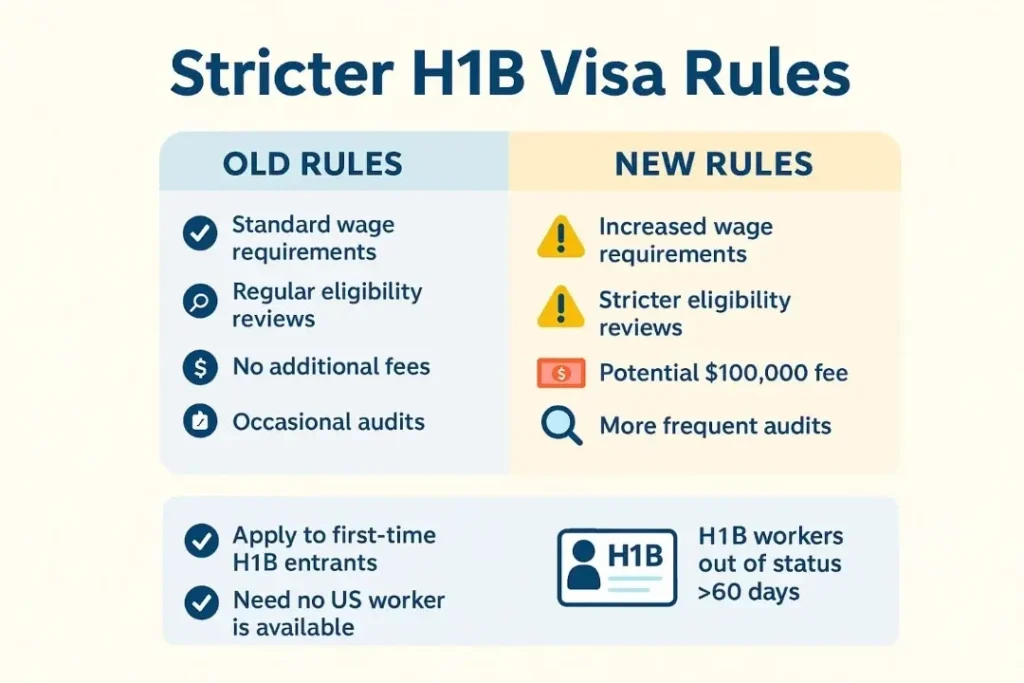Disclaimer: This article is for informational purposes only and does not constitute legal advice. Immigration laws and policies can change rapidly. Readers should consult a qualified US immigration attorney or official government sources for guidance specific to their situation.
The US immigration system has undergone several changes since Donald Trump’s inauguration as the 47th President of the United States on January 20, 2025. Immigration to the US from 2025 to 2026 is expected to change the way non-US citizens enter, work, and settle in the country. Employers and applicants can expect a more selective process and increased regulation by the US Citizenship and Immigration Services (USCIS).
A US immigration lawyer can assist employers and foreign workers with US work visa applications. This article outlines the changes in United States immigration rules under the Trump administration in 2025. We explain what to expect amidst the US immigration policy updates under Trump.
What New Immigration Rules Have Been Introduced under Trump in 2025?
As the Trump administration aims to restore America’s immigration system, end the border crisis, and prioritize American workers, it has introduced several immigration rule updates that focus on:
Mass Deportation
The new immigration rules under Trump also focus on interior enforcement to deport undocumented immigrants. This would result in increasing immigration enforcement to carry out the largest domestic deportation in American history. The Trump administration has invested in immigration enforcement to ensure that DHS, ICE, USCIS, and CBP have funding to remove undocumented immigrants. This immigration rule update has already led to the deportation of 2 million illegal immigrants, of which 1.6 million are self-deportations, according to the Department of Homeland Security (DHS).
Merit-based Immigration
Unregulated mass migration overwhelms the American labor market with low salaries and displaces hard-working Americans from their jobs. This results in stretching the country’s housing, healthcare, and educational institutions. The Trump administration’s merit-based immigration policy is designed to ensure that legal immigration in the US first considers American interests. It also ensures that the most deserving individuals attain certain privileges, including US citizenship.
Also Read: How to Immigrate to the US in 2025
The system would favor immigrants with specific skills, education, and job offers that meet the US labor needs. To implement this, the immigration system is set to prioritize individuals based on their potential contributions to the US economy and society rather than family ties. As such, the administration has proposed reducing the number of family-sponsored visas. It would focus on immediate family members and significantly limit categories for extended family members.
National Security and Border Enforcement
The changes under Trump in 2025 have led to increased efforts to strengthen border security. The proposal, ‘Border Safety and Security Act of 2025,’ if adopted, is expected to improve border barriers and expand federal authority over immigration matters. As a result, it would mandate suspending entry for individuals without valid documents if the DHS cannot detain or return them to a contiguous country. These proposed new immigration rules and national security concerns regarding undocumented immigrants can also result in extreme vetting (such as ideological screening for applicants) and travel bans.
US Work Visa Restrictions 2025
A significant change in the United States immigration rules under Trump’s administration in 2025 is the tightening of work visas. The administration has instructed the DOL and USCIS to increase compliance audits for visa sponsors. Workplace inspections and documentation checks are inclusive. While this rule may not be challenging for large companies, it poses a significant burden for startups that rely on global talent and for medium-sized employers that sponsor International employees.
The US work visa restrictions in 2025 have tightened H1B visa requirements. The same is true of other crucial work visas, such as the O-1 and EB-3. These visas, including the H1B visa, now carry a new fee to discourage misuse of the system and encourage the hiring of American workers.
What Trump’s Administration Means for Employers Sponsoring Foreign Workers

US employers must prepare for greater scrutiny and compliance in their recruiting of International employees. There would be stricter eligibility reviews for employment-based visas and more frequent audits of companies hiring overseas workers. Employers should expect wage requirements to increase and should be prepared to demonstrate that the salary offered to foreign workers meets or exceeds the salary threshold. This aligns with the Trump administration’s proposal to impose a $100,000 fee on certain H1B visa employers.
According to USCIS, this rule doesn’t apply to individuals who switch from an existing US visa category to the H1B visa without leaving the country. The rule would apply to International employees entering the US for the first time. It can also apply to H1B visa workers who have been out of status for more than 60 days and have not obtained a new job or status. Processing fees for applications may also increase, affecting small businesses.
Companies would need better documentation to justify the need for a foreign worker to fill certain positions. Additionally, companies must demonstrate that they couldn’t find a qualified US worker to take that position. Generally, employers can expect stricter rules for H1B and other skilled-worker visas, while prioritizing workers in specific high-demand fields. Seeking expert guidance from a United States immigration lawyer can help companies comply with the new rules and assess the best option for recruiting foreign workers.
Changes to Asylum and Refugee Policies under Trump 2025-2026
According to various sources, including the BBC, Al Jazeera, and Reuters, in October 2025, the Trump administration set a refugee cap of 7,500 for fiscal year 2026. Some members of Congress and refugee advocates have criticized this decision, which is the lowest in modern history since the passage of the Refugee Act of 1980. Trump had previously set a cap of 15,000 for the fiscal year 2021. For comparison, the Biden administration set a cap of 125,000 for the fiscal year 2025.
While the CBP One app can still be used to check border wait times, asylum seekers scheduling appointments to seek asylum at the southwest border port of entry can no longer use it for that purpose. According to CBP, the functionality to do so was removed on January 20, 2025, due to new asylum and refugee policies implemented under the Trump administration. This has cancelled all existing appointments. This has left many non-Mexican asylum seekers who had waited for months in a state of uncertainty, requiring them to stay in Mexico for their court hearings. New fees may also apply to asylum applications and renewals, as non-waivable fees have been proposed. The administration has also cut funding to refugee aid organizations, including services such as housing, job training, and translation.
Moreover, screening standards have become stricter, making it difficult for applicants to prove their eligibility. There is also expedited removal of ineligible applicants, allowing faster deportation without full court hearings. These changes prioritize deterrence and reduce the number of asylum seekers admitted to the US. This raises concerns among human rights groups about access to protection for people fleeing persecution from their home countries.
Also Read: Trump Unleashes Sweeping Executive Actions On Day One
Conclusion
As the US government introduced new immigration rules in 2025, what to expect from US immigration policy in 2026 under Trump may not be different. Trump’s immigration policy updates are expected to remain as proposed unless the government changes its decision. Employers seeking foreign workers must meet stricter requirements, including paying more fees. The government would prioritize admitting skilled workers who meet specific job and wage requirements over those seeking entry through family and refugee programs.
Deportation and security screening processes would even become faster. Many of these changes are happening through executive orders, rather than legislation. Employers and applicants should expect tighter scrutiny. Working with a knowledgeable United States immigration lawyer is now essential. Legal guidance can help employers and International employees understand new immigration requirements. It can also help individuals prepare comprehensive applications to avoid delays and denials, thereby increasing their chances of success.












